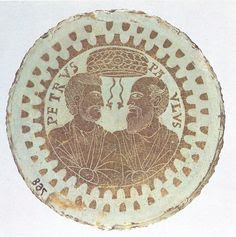Monday, December 31, 2018
The Council in Trullo and Pope Hadrian I
For the Orthodox, the Council in Trullo (Quinisext Council) is considered ecumenical and is, in turn, added on as an addendum to the fifth and sixth Ecumenical Councils of the Church. While the East approved this Council and it's related Canons (many of which were reiterations of previous ecumenical canons), it is well-known, according to Roman Catholic scholarship, that the West rejected it by way of Pope Sergius I's rejection. And though I do believe that the Quinisext Council doesn't need to be defended since other Ecumenical Councils affirm most of it's decrees, the purpose of this article is to shed light on an interesting, yet heavily disregarded set of events that take place after the fact. Some of the Quinisext Council canons are actually pretty interesting. Not only do they reiterate Constantinople's equality to Old Rome, but they also present a number of other canons which are viewed as problematic by Western standards. One canon in particular [and the main topic of this article] is the abolition of depicting Christ as a lamb (Canon 82).
Sign of the Cross: East and West, Then and Now
The Catholic Encyclopedia of 1914 is widely considered to be the "most comprehensive resource on Catholic teaching, history, and information ever gathered in all of human history." As I was reading through it this morning, I landed upon an interesting piece of information within the "Sign of the Cross" section of the document. While I must say that this section of the encyclopedia is extremely well written and contains many truths that we Orthodox Christians would agree with, one thing in particular really stood out to me regarding the method of the Sign of the Cross throughout history, especially considering that we Orthodox Christians sign ourselves from right to left and with three fingers representing the Holy Trinity.
Here is a snippet of the section with my bold emphasis added. Enjoy!
At this period the manner of making it in the West seems to have been identical with that followed at present in the East, i.e. only three fingers were used, and the hand traveled from the right shoulder to
Here is a snippet of the section with my bold emphasis added. Enjoy!
At this period the manner of making it in the West seems to have been identical with that followed at present in the East, i.e. only three fingers were used, and the hand traveled from the right shoulder to
Sunday, December 30, 2018
Haec Sancta: The Forgotten Hypocrisy
"Conciliarity" is a term that Orthodox favor and hail regularly. We are "conciliar," the Orthodox say. While we do have a first among our Primates in Constantinople, we still understand that Christ our God is the Supreme Head of the Church, even over he who is entrusted over the prime See. As such, we also believe, in conciliar fashion, that the Church, by Her bishops, can rule and depose any primate by design. We are conciliar in that we emphasize the importance of a Council and its ecclesiastical powers in certain circumstances. If you're Orthodox, this should be 101 for you, but this article will not be highlighting Orthodox conciliarity. Rather, this article will serve as a presentation to mutability, convenience, and quasi-conciliarity within the Roman Catholic Church, through a long-forgotten ecumenical/ecumenical decree known as Haec Sancta (or Sacrosancta).
Monday, December 17, 2018
Sola Scriptura Refutes Sola Scriptura
If I had to put an estimate on how many articles exist that either argue for or against the doctrine of Sola Scriptura, I would have to say that the figure would exceed tens of thousands. It is certainly no secret that Sola Scriptura has been the center of debate between Protestants and Roman Catholics/Orthodox Christians for the better part of 500 years. With that said, my intention with this article is not to provide a summarical defense against the doctrine of Sola Scriptura, but rather to let the Holy Scripture speak for Itself. In addition, I also intend to reference the Holy Fathers of the Church and their contemporaries [whom we don't regard as Saints] as a framework for what the early Church believed regarding the exclusivity of Tradition being contained within the Holy Scriptures.
Being a huge fan of referenceable material, this article will provide a basic presentation for why a Sola Scriptura framework and reading actually invalidates the doctrine of Sola Scriptura.
Being a huge fan of referenceable material, this article will provide a basic presentation for why a Sola Scriptura framework and reading actually invalidates the doctrine of Sola Scriptura.
Subscribe to:
Comments (Atom)



